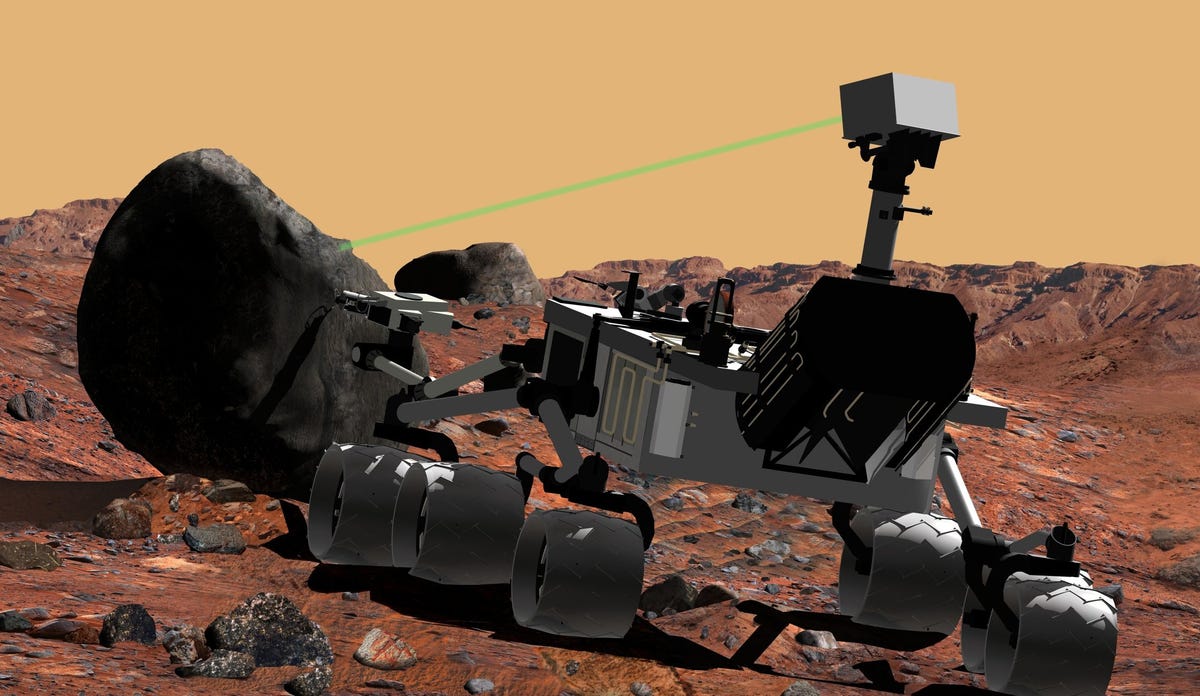Mars rover Curiosity to seek answers (images)
NASA plans to send a new and bigger rover to the Red Planet in 2011 in the continuing quest for signs of life past or present.

Mars rover Curiosity
Back on Earth, NASA is working on the next generation of Mars rover, named Curiosity, a bigger model that the space agency this week said it hopes to launch between November 25 and December 18, 2011, with a landing on Mars to occur between August 6 and August 20, 2012.
As this artist's depiction suggests, the new rover will be packing heat.
"Curiosity will have a laser on its mast that can take aim at a rock and vaporize a small spot on it," Joy Crisp of NASA's Jet Propulsion Laboratory said in a NASA Science post in October. "This produces a plasma cloud that tells us about that rock's chemistry. We'll look at the light reflected off the cloud to characterize rocks and soils from up to 9 meters away. We'll be able to classify minerals, ices, and organic molecules without having to drive as much."
Comparing Curiosity with Spirit
Well, there is at least one other, rather notable difference: Curiosity will be nuclear-powered. The rover will draw its electricity from the heat generated by the radioactive decay of plutonium. NASA says that the radioisotope system will give Curiosity more ample and more consistent power than was the case for the solar-powered Spirit and Opportunity. The expected operational life span for Curiosity will be at least a full Martian year, or 687 Earth days.
This isn't the first time NASA will have packed plutonium in a spacecraft. That was the power source for the Viking landers, which visited Mars three decades ago, as well as for missions including Pioneer, Voyager, Galileo, Cassini, Ulysses, and New Horizons--in short, every spacecraft ever launched beyond Mars.
Three generations of rover
The full-size, mission-ready Curiosity will stand about 7 feet tall, 9 feet wide, and 10 feet front to back, not counting its robotic arm. It'll weigh close to 2,000 pounds, making it much heftier than Spirit and Curiosity (about 384 pounds) and even more so than Sojourner (24 pounds).
Curiosity will be on the prowl for, among other things, organic molecules--which would indicate whether Mars was ever capable of supporting life. "The rock record is of particular interest," Crisp said in a statement. "It has a record from billions of years ago and can answer questions like 'Where and for how long might Mars have been habitable?' 'Was it cold or warm there in the past?' 'Was the water there acidic or salty?'"
Curiosity at Brainstorm
Curiosity was originally scheduled to take off for Mars in October 2009. "Despite exhaustive work in multiple shifts by a dedicated team, the progress in recent weeks has not come fast enough on solving technical challenges and pulling hardware together," JPL Director Charles Elachi said in a December 2008 statement. NASA says that the new 2011 date is the next launch opportunity, given that the positioning of Mars relative to Earth means that there's a favorable alignment for only a few weeks every other year.
Backshell and heat shield
Rover in backshell
Descent stage
Sky Crane
"Curiosity will even land in a new fashion," JPL's Joy Crisp said in October. "Spirit and Opportunity were sitting on top of a lander that hit on the surface and bounced, protected by airbags, before coming to rest and opening up. They then had to drive off the top of the lander. A descent stage called Sky Crane will gently lower Curiosity (no airbags needed) via cables, which will be cut once the rover's wheels set down."
Radar test
Rover on a string
Scarecrow
NASA says that Curiosity should be able to travel as 90 meters in an hour, or just less than the length of a football field, but will probably average just a third of that depending on steepness, soil, power levels, and other variables.
Wheels within wheels
Robotic arm
In the body of the rover itself will be other instruments, such as a "sniffer" called SAM, for Sample Analysis at Mars, that will used to detect the presence of gases--methane, for instance, could be a sign of liquid water or microbial activity, NASA says.

